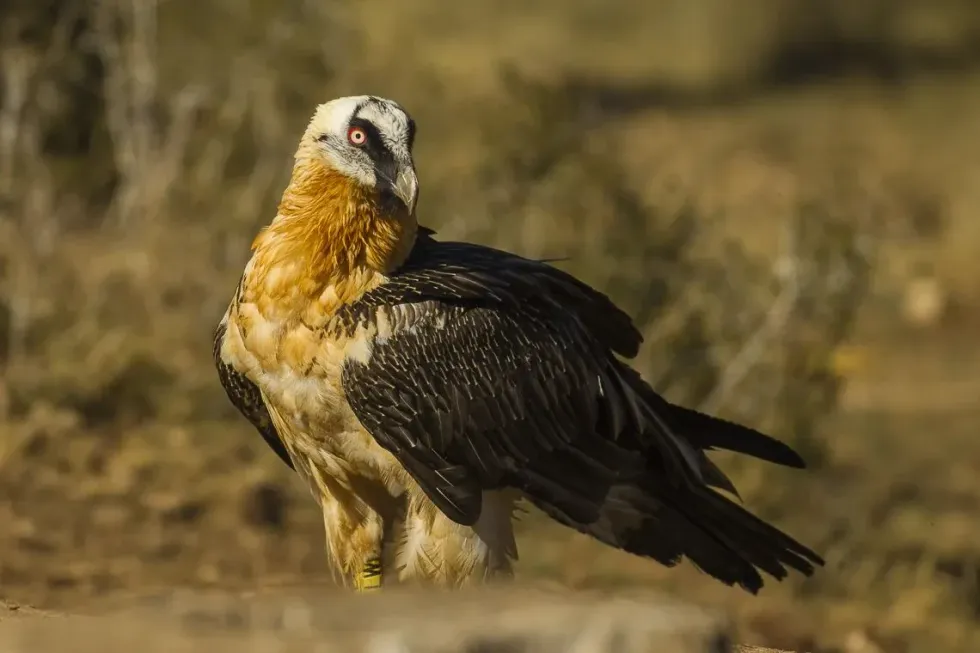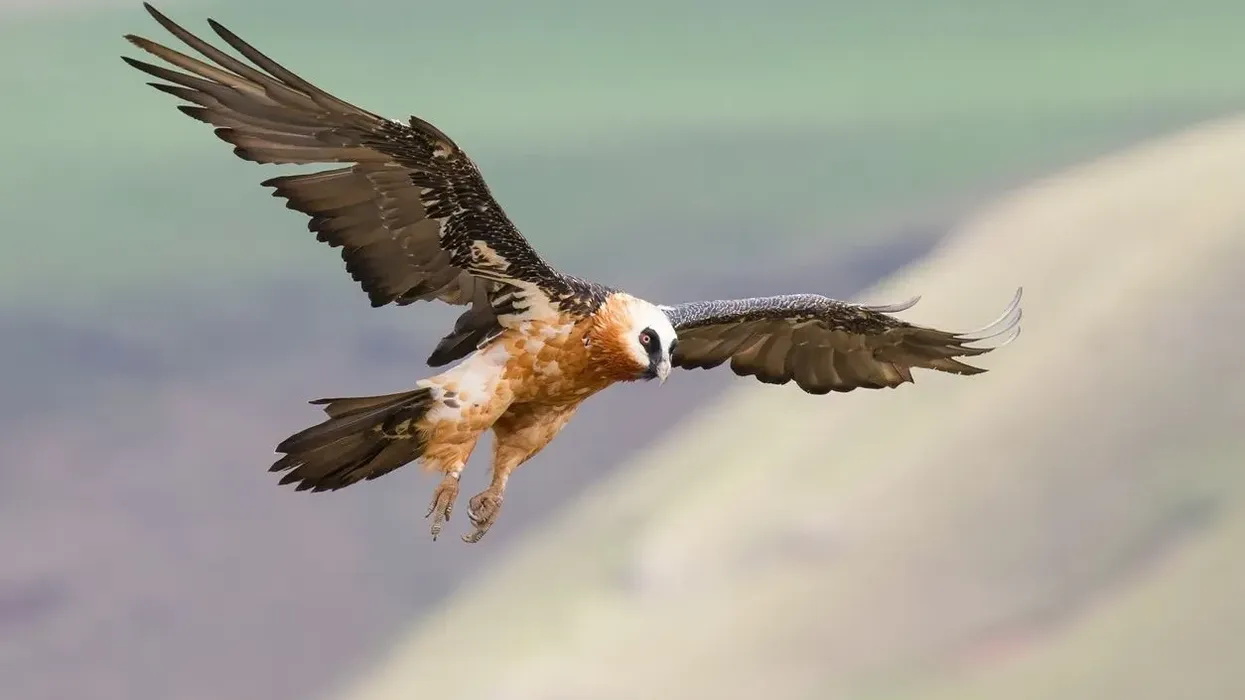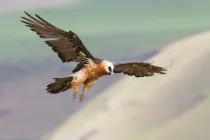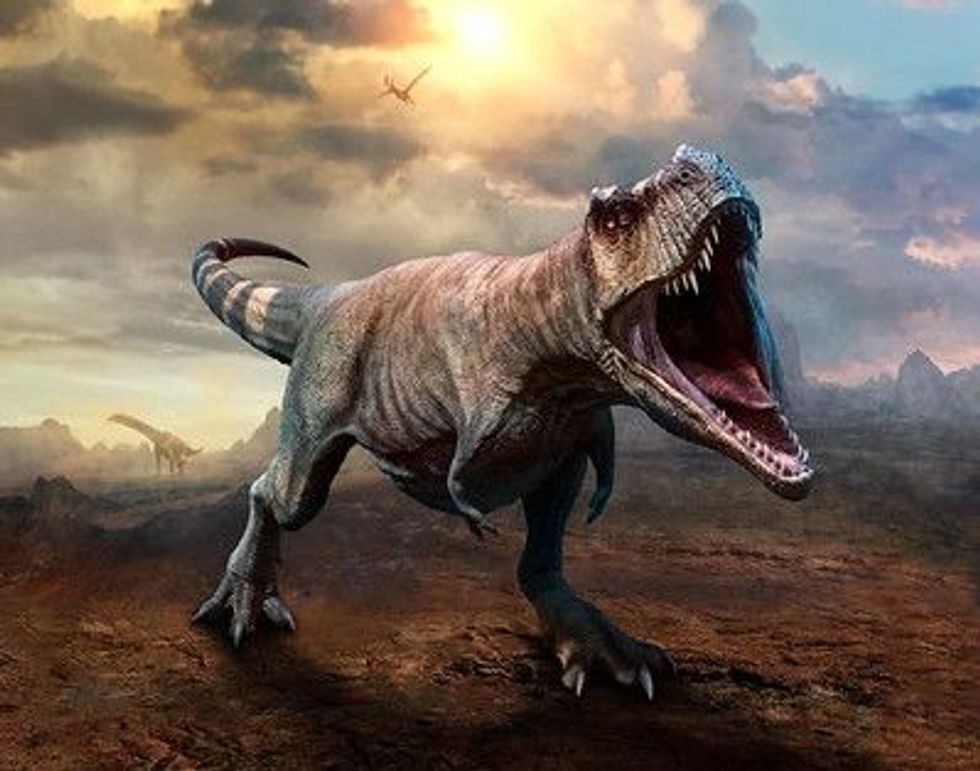Fun Bearded Vulture Facts For Kids

Are you interested in knowing more about the secret lives of birds? Let us go on a journey to know more about the Bearded Vulture (Gypaetus barbatus).
These birds also have the common name of Lammergeir, which means 'lamb vulture'. The majestic birds are part of the Vulture family; however, unlike other members, they do lack a bald head.
Instead, the Lammergeier head is covered in beautiful white or yellow feathers, making them look spectacular. The huge bird is common in different parts of Eurasia and Africa.
When it comes to their food, these birds do not like live prey. They instead rely on the bone from carrions left by other birds. They like feeding on the bone marrow of these bones.
You can recognize the Bearded Vulture by the gray-black feathers that cover the upper side of their body, which mainly consists of their magnificent wings. It's common for the females to lay two eggs in each breeding season.
As the Bearded Vulture lives in monogamous pairs, both the parents help in raising the kids. Currently, the population of these birds is at threat mainly because of the carelessness of human beings.
So, keep reading to know more about this important bird that may soon become more vulnerable. Also, check out our articles on the vulture and harpy eagle facts for more information regarding birds.
Bearded Vulture Interesting Facts
What type of animal is a bearded vulture?
The Bearded Vulture is a type of bird that mainly feeds on the bones of dead animals.
What class of animal does a bearded vulture belong to?
The Bearded Vulture belongs from the class Aves standing for birds and from the order Accipitriformes.
How many bearded vultures are there in the world?
According to the International Union for Conservation of Nature or IUCN Red List around 1,300-10,000 mature Bearded Vultures are left in this world.
Where does a bearded vulture live?
The Bearded Vulture habitat includes places like grassland, shrubland, rocky areas, mountains, and urban areas. These birds are found all over Eurasia and in some parts of Africa. Their population in Europe and Africa has been rapidly declining because of habitat loss amongst other problems.
What is a bearded vulture's habitat?
Bearded Vultures enjoy living in the mountainous regions of Asia, Europe, and Africa. They do like peaceful places and these birds tend to take up a huge territory in the wild.
Because they are scavengers, they are not likely to hunt for live prey. Some of the birds have started living in more human-populated areas due to habitat loss. Once they used to live in the Alps, but they got extinct from their native home mainly because of a lack of food sources.
Who do bearded vultures live with?
Bearded Vultures are usually solitary animals and they even like to hunt on their own. However, during the mating season, these birds choose to stay in monogamous pairs and they may even participate in hunting together.
How long does a bearded vulture live?
The average lifespan of a Lammergeier is usually 21.4 years. However, some of them have managed to live till 45 years in captivity.
How do they reproduce?
Bearded Vultures form a monogamous pair for breeding. The males even put up a dance show in the air to impress the female Lammergeier.
They are known for constructing large nests for young birds. The pairs do take care of the chicks together, and they generally have one or two eggs in a breeding season.
The breeding season may vary according to the habitat of the birds. Those that live in Europe and Asia usually mate between December to September. However, the birds living closer to India prefer the month of November to June.
Ethiopian Bearded Vultures may breed between the month of October to May. The breeding pair may even dance together in the air by locking their feet high up in the sky.
The Bearded Vulture range of eggs is usually 10 cm in length. The incubation period for the eggs lasts about 53-60 days.
The baby Bearded Vulture may live in the nest for up to 130 days. The Bearded Vulture Chick learns hunting talent from their parent. The breeding pairs bring food to the young.
They feed on bones, unlike the diet of other young Vulture species that survive on regurgitated food from their parents. The nest is cozy, and it can measure up to 3.3 ft (1 m) in depth and 8.2 ft (2.5 m) in length.
The nest is usually made up of sticks, but the nest may also be covered with animal matters left from the bone from their diet. It takes up to two years for them to reach maturity.
What is their conservation status?
The Bearded Vulture is currently listed as Near Threatened in the International Union for Conservation of Nature or IUCN Red List. There are a number of reasons for which the Bearded Vulture has diminished in number.
It includes things like habitat loss, accidental poisoning, and hunting as well as different diseases. The wild bird has already gone extinct in different parts of Africa and Europe.
A huge population of them once lived in the Alps, but recently they did go extinct at the place. Later, some pairs were introduced in the Alps to revive their population.
Bearded Vulture Fun Facts
What do bearded vultures look like?
You might be wondering why this bird is named the Bearded Vulture. It is mainly because of the hair-like black bristles that are found on the chin of this bird.
The majestic bird has beautiful plumage, and its feathers come in different colors. You may notice that the Bearded Vulture often has red color in their neck and chest area.
The Bearded Vulture skull and head tend to be small with a stronger neck. That isn't the original color of the feathers.
Instead, the Bearded Vulture likes to use iron oxide as makeup. So, they are also known as the Red Bearded Vulture.
This is done especially in the mating season to attract the female Lammergeier mates. Unlike other vultures, the Bearded Vulture has been blessed with a lot of feathers, so they do lack a bald head.
They were first thought to be a part of the Old World Vultures mainly because of their look, but since then, they have been placed with the Accipitridae.
The Egyptian Vultures are their closest living relative, which may be noticed in the shape of their beaks. The young Egyptian Vulture is usually covered in white or dark brown fuzzy feathers or down and has iconic black marks beside their eyes.
As they turn into adults, the black marks beside their eyes get even more prominent. The wings and broad tail of the bird are usually full of gray-black feathers.
However, they have white feathers on the underside of their body. In rare instances, the bird may also have a lot of white feathers, which gave rise to the name of the White Bearded Vulture.
The eyes of the species are striking because of the presence of red rings that can grow dark red when the birds are threatened or aggressive. The Bearded Vulture feet are powerful, and they can even hold bones that weigh as much as themselves.

How cute are they?
The Bearded Vulture face may look fierce, for which most people will never think of classifying the Lammergeier as cute. However, the beautiful and colorful feathers of this wild bird definitely give them an attractive and honorable look.
How do they communicate?
The Bearded Vulture is not keen on communication. However, they do communicate through shrill whistles especially when they are putting up shows in the breeding season. They may also make a 'cheek-acheek' call that resembles the call of a falcon. So, the Bearded Vulture call or the Bearded Vulture sound isn't that prominent or it can't be typically heard.
How big is a bearded vulture?
The average Bearded Vulture size is about 37-49 in (94–125 cm) in length and up to 4 ft (1.2 m) in height. They have an enormous wing size that can reach over 9.3 ft that helps them to travel over the mountains.
They have a similar size compared to their close buddies, the Griffon Vulture that has a maximum length of 36-47 in (93–120 cm).
How fast can a bearded vulture fly?
Bearded Vultures are sedentary birds, so they do not like to fly frequently. But, the most striking things are the Bearded Vulture wings.
The average Bearded Vulture Wingspan is around 7.6–9.3 ft (2.3-2.8 m). The large wing size of the birds helps them to cover an area quite quickly. Though we do not have the exact information about the speed of these birds, the average Bearded Vulture flying speed is around 25-37 mph (40-60 kmph).
How much does a bearded vulture weigh?
The average weight of the Bearded Vulture is around 9.9–17.2 lb (4.5–7.8 kg).
What are their male and female names of the species?
There are no distinct names given to the males and females of the Bearded Vulture species.
What would you call a baby bearded vulture?
A baby Bearded Vulture is called a chick.
What do they eat?
Unlike the usual belief, Bearded Vultures are actually scavengers like most other Vultures. They are also known as the 'Bone Eating Bearded Vulture' because of their affinity towards animal bones.
About 70-90% of the Bearded Vulture diet consists of bones. They love to eat bone marrow and often discard the meat on the bones to reach the marrow.
To get to the marrow, a Bearded Vulture will drop the bone from a height of 160–490 ft (50– 150 m) on a hard rock to crack it open. The Bearded Vulture eating of bone is supported by its highly acidic stomach juices that measure a one on the pH scale.
They can travel up to 435 mi (700 km) in a day to hunt for food and bone.
Sometimes when food is scarce, they do feed on tortoises and small mammals, but it is extremely rare. They can easily carry bones that have a weight of 8.8 lb (4 kg) or nearly that of their own bodies.
If a bone is small, the Bearded Vulture will most likely swallow it whole. Some of their favorite types of bones include lamb and sheep bones.
Interestingly, the Bearded Vultures living in the Ethiopian Highlands have adapted to feeding on waste left by humans. The sharp curved beak of the bird helps them to rip the bone from the carrion.
Are they dangerous?
As being a part of the birds of prey, the Bearded Vulture has been made to be a strong individual. Everything from its beak to the strong claws speaks for its power. The species is not overly aggressive and they rarely prey on other animals.
They can quickly become aggressive for humans if they get frightened or irritated. It is quite dangerous to handle birds like the Bearded Vulture without proper precautions. Humans have also used the Bearded Vulture as a sporting bird.
Would they make a good pet?
Bearded Vultures are quite intelligent, and they have been trained in the past to be kept as pets. So, technically, a Bearded Vulture pet sounds good.
However, the reality is often starkly different. These are considered birds of prey, so Bearded Vultures can become quite aggressive at certain times. This is definitely a point to consider while bringing a pet into your family.
Another thing that is prominent about the Bearded Vultures is their conservation status. As they are currently listed as Nearly Threatened in the International Union for Conservation of Nature list, you can't legally own a Bearded Vulture.
Did you know...
The old name for Bearded Vultures is 'ossifrage' which stands for 'bone breaker'.
Why are bearded vultures' eyes red?
The Bearded Vulture eyes have red sclerotic rings surrounding them. The ring is full of blood vessels which gives it a bright red color. It becomes more prominent when a Bearded Vulture is aggressive or irritated. The ring also expands when the vulture feels threatened.
Can you own a bearded vulture?
The short answer to the question is a no. Even though the Bearded Vultures are highly intelligent, their current conservation status makes them vulnerable to population decline.
So, it isn't legal for anyone to own a Bearded Vulture as their pet. However, they have been a part of the exotic pet trade for a while, and the practice is currently under the radar.
Here at Kidadl, we have carefully created lots of interesting family-friendly animal facts for everyone to discover! Learn more about some other birds including crowned eagle, or hawk.
You can even occupy yourself at home by drawing one on our Bearded vulture coloring pages.
We Want Your Photos!
More for You
See All
Bachelor of Arts specializing in Journalism and Mass Communication, Postgraduate Diploma in Sports Management

Moumita DuttaBachelor of Arts specializing in Journalism and Mass Communication, Postgraduate Diploma in Sports Management
A content writer and editor with a passion for sports, Moumita has honed her skills in producing compelling match reports and stories about sporting heroes. She holds a degree in Journalism and Mass Communication from the Indian Institute of Social Welfare and Business Management, Calcutta University, alongside a postgraduate diploma in Sports Management.
Bachelor of Law

Abdulqudus MojeedBachelor of Law
A versatile professional with a passion for creative writing and technology. Abdulqudus is currently pursuing his Bachelor of Law from the University of Lagos and has experience as a tutor, intern assistant, and volunteer. He possesses strong organizational skills and is a detail-oriented person.
Disclaimer
1) Kidadl is independent and to make our service free to you the reader we are supported by advertising. We hope you love our recommendations for products and services! What we suggest is selected independently by the Kidadl team. If you purchase using the Buy Now button we may earn a small commission. This does not influence our choices. Prices are correct and items are available at the time the article was published but we cannot guarantee that on the time of reading. Please note that Kidadl is a participant in the Amazon Services LLC Associates Program, an affiliate advertising program designed to provide a means for sites to earn advertising fees by advertising and linking to Amazon. We also link to other websites, but are not responsible for their content.
2) At Kidadl, we strive to recommend the very best activities and events. We will always aim to give you accurate information at the date of publication - however, information does change, so it’s important you do your own research, double-check and make the decision that is right for your family. We recognise that not all activities and ideas are appropriate for all children and families or in all circumstances. Our recommended activities are based on age but these are a guide. We recommend that these ideas are used as inspiration, that ideas are undertaken with appropriate adult supervision, and that each adult uses their own discretion and knowledge of their children to consider the safety and suitability. Kidadl cannot accept liability for the execution of these ideas, and parental supervision is advised at all times, as safety is paramount. Anyone using the information provided by Kidadl does so at their own risk and we can not accept liability if things go wrong.
3) Because we are an educational resource, we have quotes and facts about a range of historical and modern figures. We do not endorse the actions of or rhetoric of all the people included in these collections, but we think they are important for growing minds to learn about under the guidance of parents or guardians.







